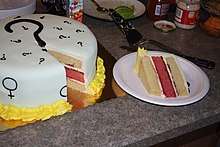Gender reveal

A gender reveal party is a celebration where either the guests, the expecting parents, or both find out the sex of the baby.
Description
The gender reveal party can be seen as an analogue of the baby shower, which also employs the trope of pink (denoting a female) or blue (denoting a male) to designate gender. However, it is typically held earlier, near the moment, formerly private, when parents learn the baby's predicted sex. Gender reveal parties also typically are open to men and women, unlike the traditionally all-female baby shower. The rise of the gender reveal party seems "inextricably tied to social media." YouTube searches report that there are "more than 500,000 videos of expectant couples slicing cakes, setting off smoke bombs and bashing piñatas to expose one of two colors: pink or blue". Other methods include the release of balloons from a box.[1]
Criticism
The term "gender reveal" often criticized as a misnomer, as all available tests measure the child's sex,[1] which may be distinguished from gender.
Gender reveal parties have become much more popular due to cell-free fetal DNA testing being available as early as ten weeks; some are marketed as detecting fetal sex as early as five weeks.[2] The DNA test is non-intrusive as it only requires blood from the mother. Previously, the sex of the unborn baby was determined via obstetric ultrasonography between 16–20 weeks. The tests are not perfectly accurate, and in cases of sex chromosome disorders or other abnormalities of development their results may not match those of fetal ultrasound.[2]
A significant issue is that as many as 4% of infants are intersex (formerly known as androgynous or hermaphrodite), though it is incredibly difficult to determine the frequency of these cases.[3][4]
According to Krylova, gender identity should not be seen as an "open-ended category" and should depend entirely upon one's biological sex.[5] Critics note the existence of nonbinary gender and reject an essential and inextricable link from sex to gender.[6]
The parties have been criticized for perpetuating gender stereotypes through themes such as "Rifles or Ruffles?" and "Wheels or Heels?".[1]
References
- 1 2 3 Hafner, Josh (March 12, 2017). "Gender reveals: Insanely popular — and also outdated?". USA Today.
- 1 2 Drabiak-Syed, Katherine (2010). "Baby Gender Mentor". Michigan State University Journal of Medicine and Law. 14 (1): 71–92.
- ↑ Nelson, Caleb; Gearhart, John (2004). "Current views on evaluation, management and gender assignment of the intersex infant". Nature Clinical Practice Urology. 1 (1): 38. doi:10.1038/ncpuro0028.
- ↑ Fausto-Sterling, Anne (1993). "The Five Sexes: Why Male and Female Are Not Enough" (PDF). The Sciences.
- ↑ Krylova, Anna (2016). "Gender Binary and the Limits of Poststructuralist Method". Gender & History. 28 (2): 307–323. doi:10.1111/1468-0424.12209.
- ↑ Butler, Judith (2002). Gender trouble.
Further reading
- Gieseler, Carly (2017). "Gender-reveal parties: performing community identity in pink and blue". Journal of Gender Studies. doi:10.1080/09589236.2017.1287066.
- Nahata, Leena (2017). "The Gender Reveal: Implications of a Cultural Tradition for Pediatric Health". Pediatrics. 140 (6): e20171834. doi:10.1542/peds.2017-1834.